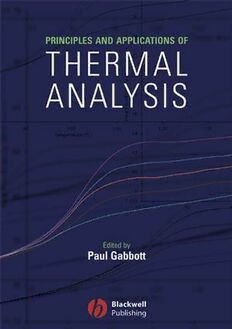Table Of ContentBLUK105-Gabbott August7,2007 12:27
Principles and Applications of
Thermal Analysis
i
BLUK105-Gabbott August7,2007 12:27
Principles and Applications of
Thermal Analysis
Edited by
Paul Gabbott
iii
BLUK105-Gabbott August7,2007 12:27
(cid:2)C 2008byBlackwellPublishingLtd
BlackwellPublishingeditorialoffices:
BlackwellPublishingLtd,9600GarsingtonRoad,OxfordOX42DQ,UK
Tel:+44(0)1865776868
BlackwellPublishingProfessional,2121StateAvenue,Ames,Iowa50014-8300,USA
Tel:+15152920140
BlackwellPublishingAsiaPtyLtd,550SwanstonStreet,Carlton,Victoria3053,Australia
Tel:+61(0)383591011
TherightoftheAuthortobeidentifiedastheAuthorofthisWorkhasbeenassertedinaccordancewiththe
Copyright,DesignsandPatentsAct1988.
Allrightsreserved.Nopartofthispublicationmaybereproduced,storedinaretrievalsystem,ortransmitted,in
anyformorbyanymeans,electronic,mechanical,photocopying,recordingorotherwise,exceptaspermittedby
theUKCopyright,DesignsandPatentsAct1988,withoutthepriorpermissionofthepublisher.
Designationsusedbycompaniestodistinguishtheirproductsareoftenclaimedastrademarks.Allbrandnames
andproductnamesusedinthisbookaretradenames,servicemarks,trademarksorregisteredtrademarksof
theirrespectiveowners.ThePublisherisnotassociatedwithanyproductorvendormentionedinthisbook.
Thispublicationisdesignedtoprovideaccurateandauthoritativeinformationinregardtothesubjectmatter
covered.ItissoldontheunderstandingthatthePublisherisnotengagedinrenderingprofessionalservices.If
professionaladviceorotherexpertassistanceisrequired,theservicesofacompetentprofessionalshouldbe
sought.
Firstpublished2008byBlackwellPublishingLtd
ISBN-13:978-1-4051-3171-1
LibraryofCongressCataloging-in-PublicationData
Applicationsofthermalanalysis/editedbyPaulGabbott.–1sted.
p.;cm.
Includesbibliographicalreferencesandindex.
ISBN-13:978-1-4051-3171-1(hardback:alk.paper)
1.Thermalanalysis. 2.Colorimetricanalysis. 3.Thermalanalysis–Industrialapplications. I.Gabbott,Paul.
QD117.T4A672007
543(cid:3).26–dc22
2007029148
SetinMinion10/12ptbyAptaraInc.,NewDelhi,India
PrintedandboundinSingaporebyMarkonoPrintMediaPteLtd
Thepublisher’spolicyistousepermanentpaperfrommillsthatoperateasustainableforestrypolicy,andwhich
hasbeenmanufacturedfrompulpprocessedusingacid-freeandelementarychlorine-freepractices.
Furthermore,thepublisherensuresthatthetextpaperandcoverboardusedhavemetacceptableenvironmental
accreditationstandards.
ForfurtherinformationonBlackwellPublishing,visitourwebsite:
www.blackwellpublishing.com
iv
BLUK105-Gabbott August7,2007 12:27
Contents
Abbreviations xv
ListofContributors xvi
1 APracticalIntroductiontoDifferentialScanningCalorimetry PaulGabbott 1
1.1 Introduction 2
1.2 PrinciplesofDSCandtypesofmeasurementsmade 2
1.2.1 AdefinitionofDSC 2
1.2.2 Heatflowmeasurements 3
1.2.3 Specificheat(C ) 3
p
1.2.4 Enthalpy 5
1.2.5 Derivativecurves 5
1.3 Practicalissues 6
1.3.1 Encapsulation 6
1.3.2 Temperaturerange 8
1.3.3 Scanrate 8
1.3.4 Samplesize 10
1.3.5 Purgegas 10
1.3.6 Sub-ambientoperation 11
1.3.7 Generalpracticalpoints 11
1.3.8 Preparingpowercompensationsystemsforuse 11
1.4 Calibration 12
1.4.1 Whycalibrate 12
1.4.2 Whentocalibrate 12
1.4.3 Checkingperformance 13
1.4.4 Parameterstobecalibrated 13
1.4.5 Heatflowcalibration 13
1.4.6 Temperaturecalibration 15
1.4.7 Temperaturecontrol(furnace)calibration 16
1.4.8 Choiceofstandards 16
BLUK105-Gabbott August7,2007 12:27
vi Contents
1.4.9 Factorsaffectingcalibration 16
1.4.10 Finalcomments 17
1.5 Interpretationofdata 17
1.5.1 Theinstrumentaltransient 17
1.5.2 Melting 18
1.5.3 Theglasstransition 22
1.5.4 FactorsaffectingT 24
g
1.5.5 CalculatingandassigningT 25
g
1.5.6 Enthalpicrelaxation 26
1.5.7 T oncooling 30
g
1.5.8 Methodsofobtainingamorphousmaterial 31
1.5.9 Reactions 34
1.5.10 Guidelinesforinterpretingdata 40
1.6 Oscillatorytemperatureprofiles 42
1.6.1 Modulatedtemperaturemethods 42
1.6.2 Stepwisemethods 44
1.7 DSCdesign 46
1.7.1 PowercompensationDSC 46
1.7.2 HeatfluxDSC 47
1.7.3 DifferentialthermalanalysisDTA 48
1.7.4 DifferentialphotocalorimetryDPC 48
1.7.5 High-pressurecells 49
Appendix:standardDCSmethods 49
References 50
2 FastScanningDSC PaulGabbott 51
2.1 Introduction 52
2.2 Proofofperformance 52
2.2.1 Effectofhighscanratesonstandards 52
2.2.2 DefinitionofHyperDSCTM 54
2.2.3 Theinitialtransient 54
2.2.4 Fastcoolingrates 54
2.3 Benefitsoffastscanningrates 57
2.3.1 Sensitivity 57
2.3.2 Measurementofsamplepropertieswithoutunwanted
annealingeffects 57
2.3.3 Separateoverlappingeventsbasedondifferentkinetics 59
2.3.4 Speedofanalysis 59
2.4 Applicationtopolymers 61
2.4.1 Meltingandcrystallisationprocesses 61
2.4.2 Comparativestudies 64
2.4.3 Forensicstudies 65
2.4.4 Effectofheatingrateonthesensitivityoftheglasstransition 67
2.4.5 Effectofheatingrateonthetemperatureoftheglasstransition 68
2.4.6 EffectofheatingrateonT ofannealedmaterials
g
(andenthalpicrelaxationphenomena) 72
BLUK105-Gabbott August7,2007 12:27
Contents vii
2.5 Applicationtopharmaceuticals 76
2.5.1 Purityofpolymorphicform 76
2.5.2 Identifyingpolymorphs 78
2.5.3 Determinationofamorphouscontentofmaterials 79
2.5.4 Measurementsofsolubility 81
2.6 Applicationtowater-basedsolutionsandtheeffectofmoisture 82
2.6.1 MeasurementofT infrozensolutionsandsuspensions 82
g
2.6.2 Materialaffectedbymoisture 83
2.7 Practicalaspectsofscanningatfastrates 83
2.7.1 Purgegas 83
2.7.2 Samplepans 84
2.7.3 Samplesize 85
2.7.4 Scanrate 85
2.7.5 Instrumentalsettings 85
2.7.6 Cleanliness 85
2.7.7 Gettingstarted 86
References 86
3 ThermogravimetricAnalysis RodBottom 87
3.1 Introduction 88
3.2 Designandmeasuringprinciple 89
3.2.1 Buoyancycorrection 90
3.3 Samplepreparation 92
3.4 Performingmeasurements 93
3.4.1 Influenceofheatingrate 93
3.4.2 Influenceofcrucible 94
3.4.3 Influenceoffurnaceatmosphere 95
3.4.4 Influenceofresidualoxygenininertatmosphere 95
3.4.5 Influenceofreducedpressure 96
3.4.6 Influenceofhumiditycontrol 97
3.4.7 Specialpointsinconnectionwithautomaticsamplechangers 97
3.4.8 Inhomogeneoussamplesandsampleswithvery
smallchangesinmass 98
3.5 InterpretingTGAcurves 98
3.5.1 Chemicalreactions 99
3.5.2 Gravimetriceffectsonmelting 101
3.5.3 Othergravimetriceffects 101
3.5.4 Identifyingartefacts 103
3.5.5 FinalcommentsontheinterpretationofTGAcurves 104
3.6 QuantitativeevaluationofTGAdata 104
3.6.1 Horizontalortangentialstepevaluation 104
3.6.2 Determinationofcontent 106
3.6.3 Theempiricalcontent 107
3.6.4 Reactionconversion,(cid:2) 110
3.7 Stoichiometricconsiderations 111
3.8 Typicalapplication:rubberanalysis 111
BLUK105-Gabbott August7,2007 12:27
viii Contents
3.9 Analysisoverview 112
3.10 Calibrationandadjustment 112
3.10.1 StandardTGAmethods 113
3.11 Evolvedgasanalysis 114
3.11.1 Briefintroductiontomassspectrometry 115
3.11.2 BriefintroductiontoFouriertransforminfraredspectrometry 115
3.11.3 Examples 117
Reference 118
4 PrinciplesandApplicationsofMechanicalThermalAnalysis JohnDuncan 119
4.1 Thermalanalysisusingmechanicalpropertymeasurement 120
4.1.1 Introduction 120
4.1.2 Viscoelasticbehaviour 121
4.1.3 Theglasstransition,T 123
g
4.1.4 Sub-T relaxations 124
g
4.2 Theoreticalconsiderations 125
4.2.1 PrinciplesofDMA 125
4.2.2 Modulianddampingfactor 127
4.2.3 Dynamicmechanicalparameters 127
4.3 Practicalconsiderations 128
4.3.1 UsageofDMAinstruments 128
4.3.2 Choosingthebestgeometry 129
4.3.3 Considerationsforeachmodeofgeometry 133
4.3.4 Staticforcecontrol 134
4.3.5 Considerationofappliedstrainandstrainfield 134
4.3.6 Otherimportantfactors 135
4.3.7 Thefirstexperiment–whattodo? 136
4.3.8 Thermalscanningexperiments 137
4.3.9 Isothermalexperiments 137
4.3.10 Strainscanningexperiments 138
4.3.11 Frequencyscanningexperiments 138
4.3.12 Step-isothermexperiments 138
4.3.13 Creep–recoverytests 138
4.3.14 Determinationoftheglasstransitiontemperature,T 139
g
4.4 Instrumentdetailsandcalibration 140
4.4.1 Instrumentdrivesandtransducers 140
4.4.2 Forceanddisplacementcalibration 141
4.4.3 Temperaturecalibration 141
4.4.4 Effectofheatingrate 142
4.4.5 Modulusdetermination 142
4.5 Exampledata 143
4.5.1 Amorphouspolymers 143
4.5.2 Semi-crystallinepolymers 145
4.5.3 Exampleof(cid:2)and(cid:3)activationenergycalculationsusingPMMA 147
4.5.4 Glasstransition,T ,measurements 150
g
BLUK105-Gabbott August7,2007 12:27
Contents ix
4.5.5 Measurementsonpowdersamples 152
4.5.6 Effectofmoistureonsamples 155
4.6 Thermomechanicalanalysis 156
4.6.1 Introduction 156
4.6.2 Calibrationprocedures 157
4.6.3 TMAusage 157
Appendix:samplegeometryconstants 162
References 163
5 ApplicationsofThermalAnalysisinElectricalCableManufacture JohnA.Bevis 164
5.1 Introduction 165
5.2 Differentialscanningcalorimetry 165
5.2.1 Oxidationstudies(OITtest) 165
5.2.2 Thermalhistorystudies 166
5.2.3 Cross-linkingprocesses 168
5.2.4 Investigationofunknowns 171
5.2.5 RapidscanningwithDSC 172
5.3 Thermomechanicalanalysis 175
5.3.1 Investigationofextrusiondefects 176
5.3.2 Cross-linking 177
5.3.3 Materialidentification 177
5.3.4 Extrusionstudies 178
5.3.5 Fire-retardantmineralinsulations 179
5.4 Thermogravimetricanalysis 180
5.4.1 Practicalcomments 180
5.4.2 Investigationofcomposition 181
5.4.3 Carboncontent 185
5.4.4 RapidscanningwithTGA 186
5.5 Combinedstudies 188
5.6 Concludingremarks 189
References 189
6 ApplicationtoThermoplasticsandRubbers MartinJ.Forrest 190
6.1 Introduction 191
6.2 Thermogravimetricanalysis 192
6.2.1 Background 192
6.2.2 Determinationofadditives 194
6.2.3 Compositionalanalysis 199
6.2.4 Thermalstabilitydeterminations 206
6.2.5 HighresolutionTGAandmodulatedTGA 208
6.2.6 HyphenatedTGAtechniquesandevolvedgasanalysis 210
6.3 Dynamicmechanicalanalysis 212
6.3.1 Background 212
6.3.2 Determinationofpolymertransitionsandinvestigationsinto
molecularstructure 215
BLUK105-Gabbott August7,2007 12:27
x Contents
6.3.3 Characterisationofcuringandcurestatestudies 218
6.3.4 Characterisationofpolymerblendsandtheeffectofadditives
onphysicalproperties 220
6.3.5 Ageing,degradationandcreepstudies 224
6.3.6 Thermalmechanicalanalysis 227
6.4 Differentialscanningcalorimetry 228
6.4.1 Background 228
6.4.2 Crystallinitystudiesandthecharacterisationofpolymerblends 231
6.4.3 Glasstransitionandthefactorsthatinfluenceit 236
6.4.4 Ageinganddegradation 238
6.4.5 Curingandcross-linking 241
6.4.6 Blowingagents 243
6.4.7 ModulatedDSC 244
6.4.8 HyperDSCTM 245
6.4.9 Microthermalanalysis 246
6.5 Otherthermalanalysistechniquesusedtocharacterise
thermoplasticsandrubbers 247
6.5.1 Dielectricanalysis 247
6.5.2 Differentialphotocalorimetry(DPC) 248
6.5.3 Thermallystimulatedcurrent(TSC) 248
6.5.4 Thermalconductivityanalysis(TCA) 249
6.6 Conclusion 249
References 250
7 ThermalAnalysisofBiomaterials ShowanN.Nazhat 256
Abbreviations 257
7.1 Biomaterials 257
7.1.1 Introduction 257
7.2 Materialclassesofbiomaterials 260
7.2.1 Metalsandalloys 260
7.2.2 Ceramicsandglasses 260
7.2.3 Polymers 261
7.2.4 Composites 262
7.3 Thesignificanceofthermalanalysisinbiomaterials 262
7.4 Examplesofapplicationsusingdynamicmechanicalanalysis(DMA)
inthedevelopmentandcharacterisationofbiomaterials 263
7.4.1 Particulateand/orfibre-filledpolymercompositesasbone
substitutes 264
7.4.2 Absorptionandhydrolysisofpolymersandcomposites 270
7.4.3 Porousfoamsfortissueengineeringscaffolds 271
7.5 ExamplesofapplicationsusingDSCinthedevelopmentand
characterisationofbiomaterials 275
7.5.1 Thermalhistoryinparticulate-filleddegradable
compositesandfoams 275
7.5.2 Plasticisationeffectofsolvents 276
7.5.3 Thermalstabilityanddegradation 278
7.5.4 Settingbehaviourofinorganiccements 278
BLUK105-Gabbott August7,2007 12:27
Contents xi
7.6 Examplesofapplicationsusingdifferentialthermal
analysis/thermogravimetricanalysis(DTA/TGA)inthedevelopment
andcharacterisationofbiomaterials 280
7.6.1 Bioactiveglasses 280
7.6.2 Thermalstabilityofbioactivecomposites 282
7.7 Summary 283
References 283
8 ThermalAnalysisofPharmaceuticals MarkSaunders 286
8.1 Introduction 287
8.2 Determiningthemeltingbehaviourofcrystallinesolids 288
8.2.1 Evaluatingthemeltingpointtransition 288
8.2.2 Meltingpointdeterminationforidentificationof
samples 289
8.3 Polymorphism 290
8.3.1 Significanceofpharmaceuticalpolymorphism 291
8.3.2 Thermodynamicandkineticaspectsofpolymorphism:
enantiotropyandmonotropy 292
8.3.3 CharacterisationofpolymorphsbyDSC 293
8.3.4 DeterminingpolymorphicpuritybyDSC 297
8.3.5 InterpretationofDSCthermogramsofsamplesexhibiting
polymorphism 302
8.4 Solvatesandhydrates(pseudo-polymorphism) 303
8.4.1 FactorsinfluencingDSCcurvesofhydratesandsolvates 304
8.4.2 Typesofdesolvation/dehydration 305
8.5 Evolvedgasanalysis 308
8.6 Amorphouscontent 310
8.6.1 Introduction 310
8.6.2 Characterisationofamorphoussolids:theglass
transitiontemperature 311
8.6.3 QuantificationofamorphouscontentusingDSC 313
8.7 PuritydeterminationusingDSC 315
8.7.1 Typesofimpurities 315
8.7.2 DSCpuritymethod 316
8.7.3 Practicalissuesandpotentialinterferences 317
8.8 Excipientcompatibility 320
8.8.1 ExcipientcompatibilityscreeningusingDSC 321
8.8.2 Excipientcompatibilityanalysisusingisothermal
calorimetry 321
8.9 Microcalorimetry 323
8.9.1 Introduction 323
8.9.2 Principlesofisothermalmicrocalorimetry 324
8.9.3 High-sensitivityDSC 324
8.9.4 Pharmaceuticalapplicationsofisothermal
microcalorimetry 325
References 327

